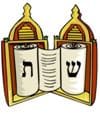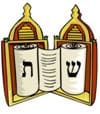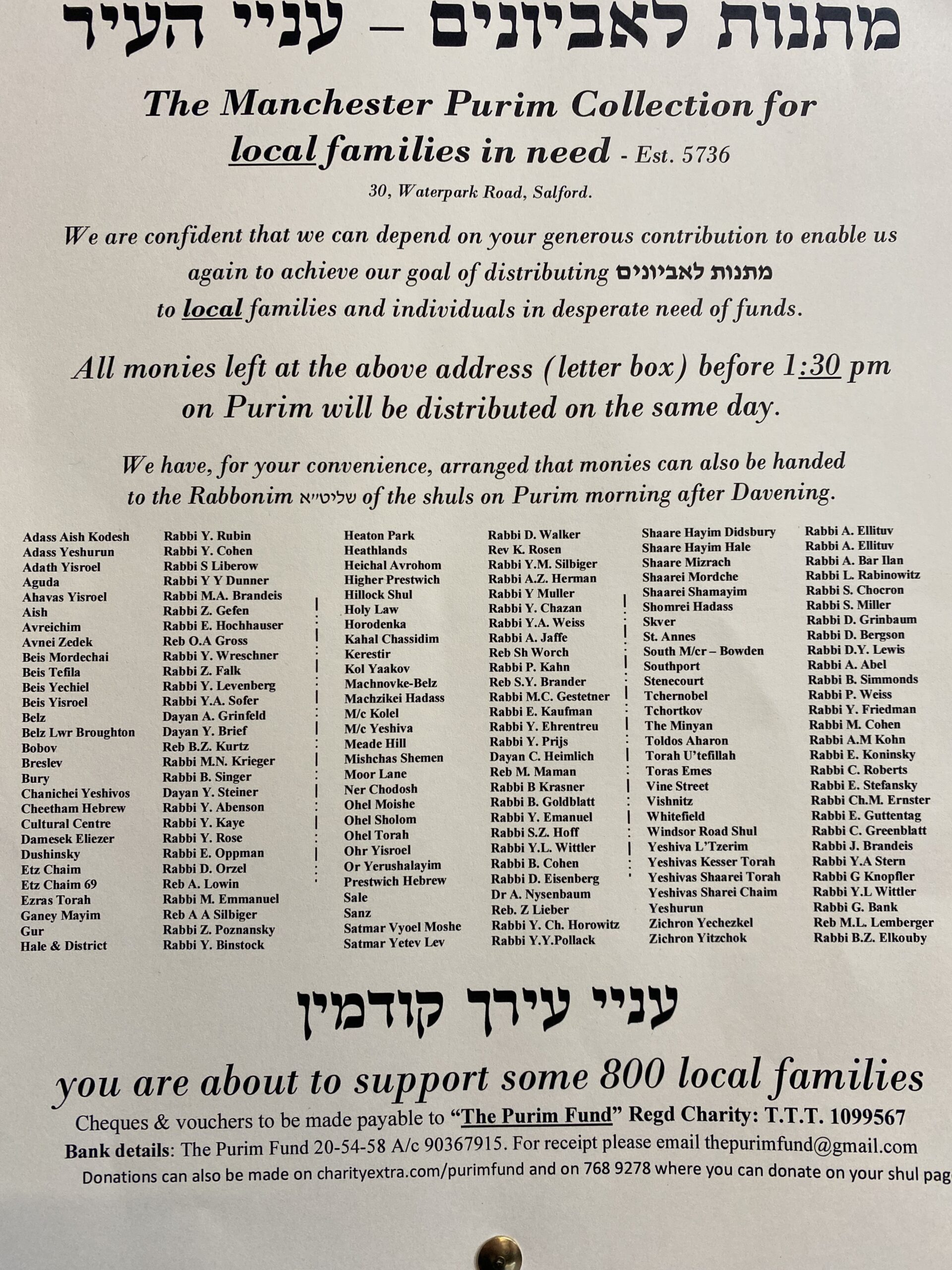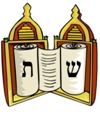
ק׳ ק׳ שׁערי תפילה

*******

(1)
שבת מברכים
is שבת מברכים
*****
(2)
****

THIS
מוצאי שבת – SUNDAY
****

This Sunday morning
clocks move forward to
BST – British Summer Time
Clocks will go forward by an hour on Sunday 30 March at 01:00 GMT

****



*****
📎 Also attached to this email 📎
(1)

(2)
KLBD

****

🗓️
לוח זמני תפילה לחורף תשפ״ה
מוצאי שבת | ערבית | שקיעה | מנחה שבת | סוף זמן קריאת שמע | הדלקת נרות | מנחה וקבלת שבת | תאריך | שבת פרשת |
Shabbat Ends | Arbit | Sunset | Minha | Shema before | Candle Lighting | Minha & Kabbalat Shabbat | Date | Parasha |
PM | PM | PM | PM | AM | PM | PM |
|
|
7:29 | 7:25 | 6:38 | 6:00 | 9:01 | 6:22 | 6:22 | 28/29 Mar | פקודי (ש''מ) |
שבת
קרבנות
8:45 am
הודו
9:00 am
******
The Book of Shemot concludes with this Torah portion. After finishing all the different parts, vessels and garments used in the Mishkan, Moshe gives a complete accounting and enumeration of all the contributions and of the various clothing and vessels that had been fashioned. Bnei Yisrael bring everything to Moshe. He inspects the handiwork and notes that everything was made according to G-d’s specifications. Moshe blesses the people. G-d speaks to Moshe and tells him that the Mishkan should be set up on the first day of the first month, i.e., Nissan. He also tells Moshe the order of assembly for the Mishkan and its vessels. Moshe does everything in the prescribed manner. When the Mishkan is finally complete with every vessel in its place, a cloud descends upon it, indicating that G-d's glory was resting there. Whenever the cloud moved away from the Mishkan, Bnei Yisrael would follow it. At night the cloud was replaced by a pillar of fire.
Ohr Somayach Institutions www.ohr.edu

החמץ בפסח – שנת התשפ”ה
אמרו רבותינו בתוספתא (פסחים פ”ג): שואלין ודורשין בהלכות הפסח קודם הפסח שלושים יום. ועל פי זה נהגו רבני ישראל בכל הדורות, שבימים הללו, מפורים ועד פסח, מלמדים ברבים את הלכות הפסח, מאחר וכל אדם מישראל צריך להיות בקי בדינים רבים הנוגעים לפסח, בכשרות המאכלים והכלים, בסדר ליל פסח ועוד.
וענין ה”חימוץ” שאסרה התורה, הוא שבהתחבר קמח דגן עם המים, ושוהה כך זמן מתאים, משתנה ההרכב הפנימי של הקמח ומתחיל להחמיץ, ומרגע שהחמיץ, אסור אותו החמץ בפסח באכילה ובהנאה, וכן אסור ליהודי להחזיק ברשותו חמץ בימות הפסח.
אולם הדבר פשוט שמאחר ומצויים לעתים שיתערבו מיני דגן בקטניות, לכן יש להזהר לברור היטב את האורז וכיוצא בו, לבל יהיו מעורבים בו חטים או שעורים וכיוצא בזה ממיני דגן, כי מצוי לפעמים במקומות שמגדלים ומייצרים בהם את האורז, שמייצרים בקרבתו גם מיני דגן, וכן בבתי האריזה של האורז, אורזים גם כן שאר מיני דגן, והם מתערבים בתוך האורז ועלולים לאסור את כל התבשיל. ולכן נוהגים לברור את האורז לפסח בתשומת לב רבה ובכובד ראש, שלש פעמים, ובשעה שילדים קטנים אינם נמצאים בסביבתם של הבודקים.
אמנם ישנם כמה מיראי ה' הספרדים שנהגו להחמיר כמנהג האשכנזים שלא לאכול אורז בפסח. ובפרט נפוץ הדבר בקרב המערבים, יוצאי מרוקו ושאר מדינות צפון אפריקה. אולם אף הם אינם מחמירים בדרך כלל, אלא באורז, אבל בשאר קטניות נוהגים היתר. ויש שנהגו לאסור אכילת חומוס גם כן.
The Laws of Chametz and Kitniyot (Legumes) on Pesach- 5785
Our Sages taught (Tosefta, Pesachim Chapter 3): We begin inquiring about and expounding the laws of Pesach thirty days before Pesach. As such, rabbis throughout the Jewish nation use the days between Purim and Pesach to teach the vast laws of Pesach to their congregations, for there are many laws everyone must be proficient in, including, the Kashrut of foods, koshering the kitchen, and the Seder night.
The Essence of Leavening
The Torah (Shemot 13) tells us regarding the holiday of Pesach: “Matzot shall be eaten for seven days; neither leaven nor sourdough shall be seen in all of your borders.” The leaven that the Torah prohibits is produced by the combination of grain-flour and water remaining in this state for a long enough period of time; this causes the internal composition of the flour to leaven (rise). From the moment the mixture begins to leaven it is considered “Chametz” which is prohibited for consumption or benefit on Pesach and it is also prohibited for a Jew to retain Chametz in his property on Pesach.
Kitniyot
Rice and all other legumes, including peas and beans, are permitted on Pesach, for the prohibition of Chametz only applies to grains and legumes are not classified as “grains”. One must nevertheless take care to check the grains of rice well to make sure that no kernels of wheat or barley are mixed inside, for it is fairly common that in some places where rice is grown or packaged, other grains are also grown or packaged in close proximity as well and some kernels of these grains can easily become mixed into the rice and indeed make one’s entire dish prohibited for consumption (for even one tiny crumb of Chametz can prohibit a large pot of food). Thus, it is customary to check through rice three times before Pesach with all due concentration and seriousness, at a time when small children are not present to disrupt the individual checking.
The Custom of Ashkenazi Jewry and Some Sephardic Communities
Due to fear that kernels of various grains may have become mixed into the legumes, Ashkenazim customarily prohibit the consumption of legumes on Pesach. Indeed, the greatest Ashkenazi authorities enacted that it is completely prohibited to eat any legumes on Pesach. However, this prohibition was not accepted at all by most Sephardic and Middle Eastern communities. A Sephardic individual should not act stringently regarding this matter for several reasons.
However, there are several G-d-fearing Sephardic communities who are stringent and customarily abstain from eating rice on Pesach. This is especially common among Moroccan and other North African communities. However, even they are customarily stringent only with regards to rice, but they do eat other forms of legumes. Some customarily abstain from eating chick peas on Pesach as well.
The Issue This Year
This year, 5785, there is an additional halachic concern that arises since Erev Pesach coincides with Shabbat, a phenomenon which occurred twice in the past five years and will not occur again for twenty years (until the year 5805/2045). There are many laws regarding such an occurrence, and we shall discuss everything in due time, G-d-willing























